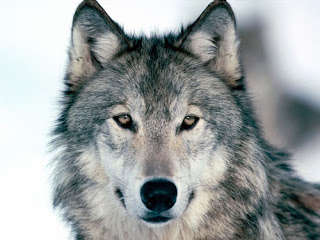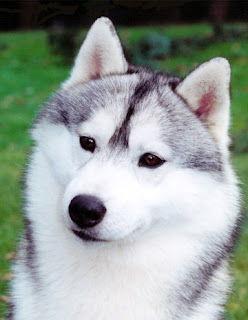
Gray Wolf
Wolves (Canis lupus) are the largest (in terms of size) among the wild relatives of the domestic dog (Canis lupus familiaris). In fact, dogs are actually a kind of wolf—remember the movie Babe (1995) where the sheep called the Border Collie dog ‘wolf?’ Domestication and breeding have turned domestic wolves into different fantastic forms (breeds) indistinguishable from the wolf. Some dog breeds, like the Siberian Husky and the Alaskan Malamute, look like ‘designer’ wolves. Some people cross dogs and wolves to produce ‘wolfdogs.’
Dogs might be a type of wolf, but wolves are very different from dogs: For one, their fur are better insulators, like wolverine fur, with its ability to prevent ice from forming when one breathes on it. Another differences are sense of smell (weaker than most hunting dogs), eyesight (weaker, but powerful than that of most dogs during night time) and hearing (imagine being able to clearly hear the sound of falling autumn leaves). They also have a distinct bone and teeth structure apart from dogs. In terms of behavior, wolves successfully pass behavioral tests dogs routinely fail.
Wolves used to have the most widespread territory among the canines until humans came along.
Size and Weight
Wolves are larger than most dogs, but they tend to be bigger at higher latitudes following Bergmann’s Rule. They can reach 80 to 85 cm (2.62-2.79 ft) tall, and 105-160 cm (3.44-5.25 ft) long; the tail being ⅔ the length of the head and body combined. Wolves are heavier in Europe (up to 38.5 kg or 85 lb), followed by North America (up to 36 kg or 79 lb), India/Arabia (25 kg or 55 lb) and North Africa (13 kg or 29 lb), with females weighing less.
Types of wolves
Strictly speaking there is only the grey wolf. Other wolves like the red wolf, Indian wolf, and Canadian wolf, are considered subspecies or—as currently debated for the red wolf—hybrids with other canine subspecies. The different subspecies are considered to have developed their distinctive forms as local adaptations.
The most distinct differences among groups of wolves are in color—ranging from pure white, to offwhite to browns, reds, grays to pure black; the latter occurring whenever a wolf also has dog in its parentage.
Dogs might be a type of wolf, but wolves are very different from dogs: For one, their fur are better insulators, like wolverine fur, with its ability to prevent ice from forming when one breathes on it. Another differences are sense of smell (weaker than most hunting dogs), eyesight (weaker, but powerful than that of most dogs during night time) and hearing (imagine being able to clearly hear the sound of falling autumn leaves). They also have a distinct bone and teeth structure apart from dogs. In terms of behavior, wolves successfully pass behavioral tests dogs routinely fail.
Wolves used to have the most widespread territory among the canines until humans came along.
Size and Weight
Wolves are larger than most dogs, but they tend to be bigger at higher latitudes following Bergmann’s Rule. They can reach 80 to 85 cm (2.62-2.79 ft) tall, and 105-160 cm (3.44-5.25 ft) long; the tail being ⅔ the length of the head and body combined. Wolves are heavier in Europe (up to 38.5 kg or 85 lb), followed by North America (up to 36 kg or 79 lb), India/Arabia (25 kg or 55 lb) and North Africa (13 kg or 29 lb), with females weighing less.
Types of wolves
Strictly speaking there is only the grey wolf. Other wolves like the red wolf, Indian wolf, and Canadian wolf, are considered subspecies or—as currently debated for the red wolf—hybrids with other canine subspecies. The different subspecies are considered to have developed their distinctive forms as local adaptations.
The most distinct differences among groups of wolves are in color—ranging from pure white, to offwhite to browns, reds, grays to pure black; the latter occurring whenever a wolf also has dog in its parentage.

Black Wolf
As previously mentioned, a black wolf is a melano gray wolf. Genetic
research from Stanford University School of Medicine and the University
of California, Los Angeles (UCLA) revealed that black wolves owe their
distinctive color to mutations that occur through the wolf-dog hybrid.

Wolfdog
As the name implies, wolfdogs (aka, ‘wolf-dog hybrids’ or ‘wolf
hybrids’) result from the mating of various subspecies of wolves and
dogs (which, itself, is a wolf subspecies). They may result from
accidental matings or controlled breedings by an industry catering to
people who want to buy ‘exotic’ pets or to effect certain desirable
traits—say, for military purposes. To qualify as a wolfdog, your dog
must have a wolf parent within the last five generations. In controlled
crosses, ‘wolf-looking’ dogs (like Siberian Huskies, Alaskan Malamutes
and German Shepherds) are generally used to mate with the Gray Wolf
parent.

Snow Wolf

Gray Wolf

Wolves

Beautiful Wolf

Wolf Roaring












2 comments:
im interested in wolf cubs if u have any contact me at equanshas@gmail.com
Hey Joe! Thanks for dropping by. Maybe you meant a puppy of any breed that looks like a wolf like a Siberian Husky? :)
Anyway, I'm sure some of our readers here would be more than happy to help you out so keep your email in check.
Post a Comment